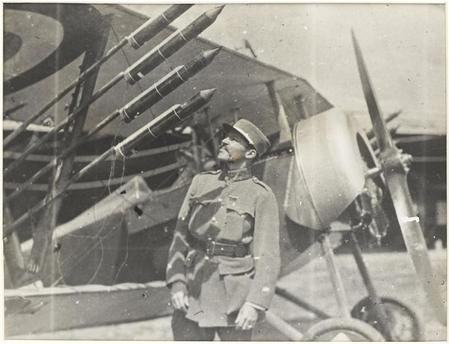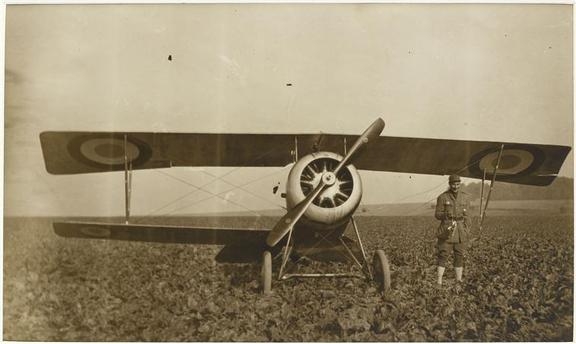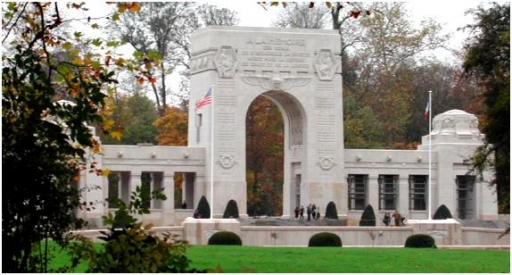The United States & France are preparing to rededicate a memorial honouring American pilots who flew in the First World War. Ahead of the ceremony at the Lafayette Escadrille Memorial near Paris, CN’s Patrick Gregory looks back at the impact of the volunteer airmen on the Allied war effort.
Although the United States had formally entered the war in April 1917 – and although American troops had seen their first combat action that autumn – it was to be nearly a full year before the pilots of the fledgling U.S. Air Service would take to the skies.
The problems the new air arm had encountered along the way were many and varied: challenges of organisation and supply, the tactical considerations of where they were to be deployed and the role they would play when they got there. As it happened, and when the time came, they were assigned the area of Toul in the north-east of France, near Nancy: a comparatively quiet sector in combat terms, where the largely untested American pilots could cut their teeth and make the transition from training school to active units. As a combat zone it would assume greater importance the longer 1918 wore on – as American troops began their ground assaults in earnest – but in that early period of spring 1918, the first of the new squadrons to be assembled used this relatively low-key atmosphere to bed in.
The 95th ‘Kicking Mule’ and 94th ‘Hat in the Ring’ Aero Squadrons took up their positions in February and March respectively, but it was to be a slow start. They and other units would be forced to move base on more than one occasion, and other teething problems soon presented themselves. A fresh delivery of planes arrived in the first week of March – three dozen new Nieuport 28 fighters. The consignment was much welcomed, but some from the 95th Squadron had to fly on the front without guns at first because the weapons had not arrived; others had yet to receive the necessary gunnery training.
Elite
However, key members of these squadrons were not so untried and they were not so untested. In fact, they had been in active service for two years: since the April of 1916. They were part of an elite band of pilots known as the Lafayette Escadrille, and they were volunteers. A steady stream of American volunteers had found their way to France since the outbreak of hostilities in 1914, eager to lend their weight to the Allied cause. Most had done so as non-combatant ambulanciers, ferrying Allied casualties from the front line or driving supply trucks. But others had sought a more active role as foreign legionnaire fighters, including some who had to put themselves forward for flight training, to fly with French forces.

Norman Prince: founder of the Lafayette Escadrille (Photo courtesy of US World War I Centennnial Commission)
By 1915 a sufficient number of such volunteers existed for the idea of an all-American unit to take hold, the brainchild of three men: Edmund Gros – a San Franciscan of French heritage, whose day job saw him serve as the medical director of the American Field Service in Paris – and two pilots who would become founding members of the new escadrille, Norman Prince and William Thaw. Together the three lobbied the French authorities to help train the squadron and put them into service. The scheme was approved in August 1915, with officials appreciating both the need for a new cadre of eager recruits and the positive publicity which could be garnered in the still neutral United States.
It would take until the following April before the squadron – the French Air Service’s escadrille SPA. 124 – was operational. But the Lafayette Escadrille had been born, named in fitting – and deliberately eye-catching – honour of the French aristocrat and military officer who had fought for the United States in their Revolutionary War.
The aircraft and uniforms of the new unit may have been French, as was the commander, Georges Thenault, but the core of the group, the ‘Valiant 38’, could boast American backgrounds and heritage. With their insignia of a Sioux warrior’s head and (real) lion cub mascots Whiskey and Soda, the unit quickly took off both as a fighting force and as an idea which would seize the public’s imagination; and little wonder. These dashing young men – a good many from wealthy families or with Ivy League backgrounds – raised spirits and generated many column inches on both sides of the Atlantic, appearing to fly like gentlemen players over the messy quagmire of battle.
Verdun debut
The squadron saw its first major action in mid-May 1916 during the Verdun campaign and within days, pilot Kiffin Rockwell was able to record the unit’s first aerial victory. Other successes soon followed, as did action in other sectors and other battles – the Somme, the Nivelle Offensive and the Aisne. But so too did the casualties, and the ranks of the original 38 and the squadron’s five French pilots had to be augmented with new recruits. But that as it turned out, was not a problem. Such was the name the Lafayette had begun to garner, that those would-be replacements were queueing to get in. Not only would the escadrille’s ranks be replenished, but before long a second grouping, the Lafayette Flying Corps would be formed. This new group, over 200 in total, was parcelled up and deployed through other fighter units of the French air arm.
Some aviation historians have contended that the 124 squadron’s main legacy, or its main contribution, lay in the inspiration it gave to others rather than in the hard numbers of kills it achieved on the front, however valiantly it fought there. But be that as it may, members of the Lafayette Escadrille would go on to play an important leadership role in U.S. Air Service and its prosecution of the war in north-eastern France: William Thaw would head up the U.S. Air Service’s 3rd Pursuit Group; Ray Claflin Bridgman take charge of the 22nd Aero Squadron; Captain Robert Soubiran would command the 103rd Aero Squadron for a period, Kenneth Marr briefly take the helm of the 94th.
Other notable names to spring from the ranks of the squadron and its Flying Corps successor included James Norman Hall and Charles Nordhoff who would in time form a writing partnership to pen a fictional account of their flying days in the Falcons of France and later still – and far from the airfields of wartime France – Mutiny on the Bounty. But perhaps the star of the escadrille’s show was the French-American Raoul Lufbery, the unit’s leading ace with some 17 confirmed kills of the unit total of 40. Lufbery would go on to become operations officer of the celebrated 94th ‘Hat in the Ring’, before being killed in action in May 1918.
Memorial rededication

Courtney Campbell landed minus an entire lower wing of his plane following an incident on the Aisne (Photo courtesy of US World War I Centennnial Commission)
Now in 2016, to mark the work of these American pioneers a monument erected in their memory after the war, the Lafayette Escadrille Memorial outside Paris, will be rededicated. The ceremony on 20th April will cap a joint French-United States renovation project which has taken place over the past decade. The Memorial was built in 1928 with private donations, and is the burial place of 49 Americans who died in the war, commemorating not only the original 38 American members of the squadron but also the legionnaires who followed them in the Lafayette Flying Corps. But the memorial had fallen into a state of disrepair in recent decades, until a joint taskforce was created by the American government and American Battle Monuments Commission with the French Ministry of Defence to restore it.
One hundred years on from the Lafayette Escadrille’s inception, the French government will hold a ceremony to remember the unit, marking the moment with a flyover, presentations by a Sioux Chief, and speeches by both French and American dignitaries.
For more information about the Lafayette Escadrille Memorial, and other American projects marking the First World War Centenary, visit the US World War One Centennial Commission website.
Images courtesy of World War One Centennial Commission
Patrick Gregory is co-author with Elizabeth Nurser of An American on the Western Front: The First World War Letters of Arthur Clifford Kimber, 1917-18 – to be published by The History Press on July 7th 2016.
Also in Centenary News: Winning design for new US World War I Memorial in Washington DC
